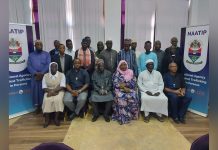Africa-Press – Gambia. Africa faces major education challenges: low internet access (36%), teacher shortages, and limited resources. EdTech offers potential solutions, but scaling these tools requires partnerships that address infrastructure, funding, and local needs. This article outlines five approaches to expand EdTech in underserved areas:
Public-Private Partnerships (PPPs): Combine government reach with private sector expertise to improve infrastructure and align with national education goals. Examples include Kenya’s Safaricom and Rwanda’s Coding Academy.
NGO Collaborations: Leverage NGOs’ community trust to deliver offline tools, train educators, and adapt content to local languages, as seen with Shule Direct and XamXam.
Regional Government Consortia: Unite nations to share resources, standardize curricula, and lower costs. The AUDA-NEPAD EdTech 2030 Vision sets a framework for cooperation.
Corporate Sponsorship & Social Impact Investment: Engage companies like Microsoft and Safaricom for funding, expertise, and scalable solutions. Social investors focus on measurable educational outcomes.
Community-Led Partnerships: Empower local communities to co-create and maintain solutions, ensuring relevance and long-term adoption. Tools like preloaded tablets and solar-powered hubs are key.
Each model offers ways to address Africa’s unique challenges, from low connectivity to funding gaps, while driving progress in digital education.1. Public-Private Partnerships (PPPs)
Public-private partnerships (PPPs) play a vital role in expanding EdTech across Africa by combining government resources and reach with private sector expertise and efficiency. This collaboration addresses infrastructure gaps and educational needs on a large scale, creating a dynamic framework that blends public support with private innovation.
At the heart of a successful PPP is leveraging the unique strengths of each partner. Governments provide access to public schools, policy backing, regulatory guidelines, and the ability to reach underserved communities. Meanwhile, private EdTech companies contribute technical know-how and creative solutions that can adapt to changing educational demands.
A clear structure is crucial for these partnerships to succeed. The AUDA-NEPAD EdTech 2030 Vision serves as a guiding policy framework, developed through collaboration among governments, EdTech startups, and international organizations. This phased plan outlines steps for scaling EdTech: foundation building (2024–2026), system integration (2026–2028), and consolidation and export (2029–2030). Typically, PPPs include joint steering committees, performance-based contracts, and ongoing stakeholder engagement to ensure the balance between educational goals and business viability.
Examples of successful PPPs highlight their potential. During the COVID-19 pandemic, Kenya’s Safaricom collaborated with educators to provide free digital learning resources, demonstrating how public-private efforts can address urgent needs. In Rwanda, the government partnered with local universities and EdTech startups to establish the Rwanda Coding Academy, a program focused on developing homegrown tech talent and solutions tailored to local contexts. These examples emphasize the importance of local capacity building and strong government leadership in fostering sustainable EdTech systems.
For EdTech startups aiming to scale in underserved regions, PPPs offer significant advantages, including access to large user bases, public funding, and increased credibility. Aligning products or services with national education goals and curricula greatly improves the chances of forming successful partnerships with governments. Companies that demonstrate measurable outcomes and a deep understanding of local contexts are better positioned to secure long-term collaborations.
However, challenges persist. Bureaucratic delays, differing priorities, and concerns over data privacy can complicate these partnerships. Lengthy procurement processes and unclear regulations can also hinder progress. Addressing these issues requires building trust with government stakeholders and engaging in policy discussions early on.
Despite these hurdles, clear metrics are key to guiding effective strategies. Success in PPPs is measured by improvements in learning outcomes, user engagement, outreach in underserved areas, and teacher empowerment. Other important indicators include cost-effectiveness, scalability, and the use of local languages and culturally relevant content.
As governments in countries like Kenya and South Africa roll out national digital literacy initiatives and cloud-based platforms, the opportunities for EdTech companies to align with these goals are expanding. Pilot projects with well-defined metrics can showcase value to public sector partners, paving the way for larger collaborations. Transparent reporting and the ability to adapt to changing needs are essential for maintaining trust and achieving long-term, scalable impact in underserved communities.
2. NGO and Nonprofit Collaborations
Collaborations between NGOs and nonprofits play a crucial role in connecting EdTech advancements with the needs of local communities. These partnerships combine the technical know-how of EdTech companies with the deep-rooted community trust and social expertise that NGOs have built over years of working in underserved areas. Together, they create solutions tailored to real-world challenges.
For instance, NGOs help EdTech companies implement offline and low-bandwidth solutions like local content caching, preloaded tablets, and solar-powered learning hubs. These tools are designed to work even in remote regions where connectivity is limited.
Take the example of Shule Direct. By partnering with local organizations in Tanzania, Uganda, and Kenya, they reached over 5 million students and 70,000 teachers. Their efforts, which included distributing curriculum content across web, mobile, and offline channels, resulted in a 45% improvement in test scores. Similarly, the Africa Training Institute has successfully worked with NGOs to distribute preloaded tablets and provide community training in areas with connectivity challenges.
NGO partnerships also shine in adapting EdTech solutions to local languages and cultural contexts. A great example is Senegal’s XamXam platform, which serves 1.2 million users by offering curriculum-aligned digital content in Wolof. This was made possible through NGO support, which brought insights into local languages, cultural nuances, and learning preferences.
Beyond technology, NGOs play a vital role in mobilizing local facilitators, training educators, and maintaining community relationships. These grassroots efforts ensure that digital tools are not only adopted but also used effectively, fostering long-term change.
For EdTech startups, forming partnerships with NGOs early on can make a big difference. Jointly conducting needs assessments and co-designing solutions that align with local realities can create a strong starting point. Building trust through open communication, sharing impact data, and offering continuous training for NGO staff are key steps toward lasting collaborations.
A mobile-first approach is particularly effective in these settings. Technologies like SMS and USSD, which work on basic phones, have proven to reach millions of users. Measuring success requires a mix of quantitative metrics, such as enrollment rates and test scores, and qualitative feedback, like improvements in digital literacy. These insights help paint a fuller picture of educational progress.
However, challenges do arise. Misaligned goals and limited resources can strain partnerships. While EdTech companies often focus on scalability and efficiency, NGOs prioritize social inclusion and community impact. Addressing these differences through clear agreements and regular communication can strengthen partnerships and help scale EdTech solutions across Africa.
Initiatives like the African Union’s EdTech 2030 vision underscore the importance of cross-sector collaboration, including partnerships with NGOs, to create inclusive and resilient education systems. NGOs bring the local expertise and community connections needed to navigate complex challenges and ensure that digital tools reach even the most marginalized learners.
For those eager to follow the development of such partnerships and other innovations in African technology, Tech In Africa provides daily updates on startups, entrepreneurs, and sector trends across the continent.
3. Regional Government Consortia
Regional government consortia bring together multiple African nations to expand EdTech solutions across borders. By fostering cross-national collaboration, these partnerships build on earlier models of cooperation, extending their influence beyond individual countries.
At the forefront of this effort is the African Union Development Agency-NEPAD (AUDA-NEPAD), which has introduced its draft African EdTech 2030 Vision & Plan. This initiative envisions a future where a student in rural Tanzania can access high-quality digital lessons in Kiswahili, while educators from different countries share resources effortlessly.
To make this vision a reality, common standards for curriculum, technical protocols, and data privacy are key. These shared frameworks ensure that EdTech platforms can operate smoothly across different markets. As a result, educational tools and content can be easily adapted and rolled out in neighboring nations.
Pooling resources is another major advantage of regional collaboration. By combining efforts in areas like infrastructure development, teacher training, and content creation, governments can reduce costs and make EdTech more accessible. Joint procurement strategies also provide better vendor terms and create economies of scale, which are especially important for countries with limited budgets.
AUDA-NEPAD’s phased approach highlights the potential of regional cooperation. Its framework addresses critical challenges such as aligning national policies, managing cross-border data flows, and bridging infrastructure gaps. It also emphasizes data privacy and regulatory harmonization, ensuring a consistent and secure approach to EdTech implementation.
Events like the EdTech Connect Conference exemplify the benefits of regional collaboration. These gatherings bring together policymakers and innovators from different countries to exchange best practices and explore scalable solutions. Through such initiatives, regional consortia streamline EdTech deployment, creating a more unified approach to education technology.
For EdTech startups, these consortia open doors to cross-border scaling opportunities. Companies that design solutions with multilingual support and platform interoperability can access larger markets than single-country strategies would allow. Participating in regional policy forums organized by AUDA-NEPAD also helps align products with emerging standards, while providing access to broader distribution networks.
Measuring the success of these consortia involves tracking metrics like student access rates, teacher digital literacy improvements, learning outcomes, and platform interoperability. Data collected at both national and regional levels offers valuable insights for shaping policies and monitoring progress.
International organizations like the Global Partnership for Education (GPE) and UNICEF play an essential role in this ecosystem. They provide technical support, funding, and capacity-building programs, which strengthen local research capabilities and help scale successful EdTech models across multiple countries.
The consortium model strikes a balance between achieving scale and maintaining local relevance. By promoting multilingual and locally developed courseware, while encouraging adaptation to diverse cultural contexts, these partnerships ensure that EdTech solutions remain community-focused. This approach paves the way for digital education to reach underserved learners across Africa, creating sustainable pathways for growth.
4. Corporate Sponsorship and Social Impact Investment
Beyond partnerships with governments and NGOs, corporate sponsorship and social impact investments offer powerful ways to expand digital education. These collaborations not only provide funding but also bring strategic expertise, helping EdTech startups address challenges like infrastructure gaps while scaling their impact.
Corporate players are stepping up in a big way. Major tech companies like Microsoft are leading the charge with initiatives aimed at improving digital literacy and teacher training across Africa. By supplying devices, software, and training resources to schools in underserved areas, Microsoft integrates its global CSR goals with local educational needs.
Google’s Project Loon, which ran from 2019 to 2021, took an innovative approach by using high-altitude balloons to improve internet connectivity in rural Kenya, demonstrating how tech-driven infrastructure investments can support EdTech.
Telecom companies are also making a difference. For instance, Safaricom partnered with educational platforms during the COVID-19 pandemic to provide free access to digital learning materials. By offering subsidized data packages, they made digital education more accessible, increasing adoption among students and teachers in Kenya. This initiative highlights how telecom companies can use their networks to support education while fulfilling their CSR objectives.
But corporate involvement isn’t just about giving back. Companies investing in EdTech through social responsibility programs also enhance their brand image, meet ESG commitments, and contribute to workforce development. Supporting education helps these companies cultivate future talent, encourage innovation, and strengthen local economies – creating business benefits that often outweigh the initial investment.
Social impact investors take a different approach than traditional venture capital. They often use blended finance models – combining grants, equity, and debt – to fund EdTech startups. These investments are tied to specific milestones, include impact measurement requirements, and sometimes offer technical assistance. The goal is to ensure both financial stability and measurable improvements in education.
Real-world examples show how effective these models can be. For instance, TechnoServe‘s Nova EdTech platform expanded entrepreneurial training to thousands of users by leveraging business sponsorships.
When deciding where to invest, corporate sponsors and impact investors focus on several key factors: scalability, alignment with local curricula, measurable learning outcomes, sustainability, and the ability to reach marginalized communities. They also value data-driven decision-making and the potential for cross-sector collaborations.
For EdTech startups looking to attract these partnerships, it’s critical to demonstrate clear impact metrics. Companies need to show strong business models that align with corporate CSR goals. Collaborating with local governments, NGOs, and community organizations can also boost credibility and broaden their reach, making them more appealing to sponsors and investors.
To maintain trust, measurement and reporting are essential. Corporate sponsors rely on key performance indicators (KPIs) such as student engagement rates, test score improvements, teacher adoption rates, and the extent of reach in underserved areas. Regular updates and third-party evaluations ensure transparency and accountability, giving sponsors confidence in their investments.
However, this model isn’t without challenges. Misaligned goals between sponsors and startups, sustainability concerns once funding ends, and the risk of prioritizing marketing over real educational needs are potential pitfalls. EdTech companies must also avoid over-reliance on external funding and ensure their solutions remain locally relevant.
Given Africa’s digital landscape, mobile-first strategies are particularly appealing to corporate sponsors. With over 400 million smartphone users but only 36% internet penetration, mobile-based learning platforms offer scalable, offline solutions that align with corporate and impact investor goals. These approaches are well-suited for reaching underserved markets.
Successful partnerships go beyond funding – they involve co-designing solutions with local stakeholders, building teacher capacity, and leveraging mobile-first and offline technologies. Long-term sustainability, locally relevant content, and continuous impact assessments are crucial for ensuring meaningful and lasting educational change.
5. Community-Led and Grassroots Partnerships
While corporate sponsorships and government alliances bring resources and scalability, community-led partnerships offer something just as valuable: genuine local ownership and relevance. These grassroots approaches allow communities to directly shape EdTech solutions that address their unique challenges, rather than implementing outside ideas that may not fit. While formal partnerships focus on broad reach, grassroots efforts ensure local alignment, creating a balanced approach to advancing EdTech in Africa.
When communities actively participate in designing and maintaining EdTech solutions, the results are more aligned with their specific needs. Grassroots partnerships emphasize what truly matters to local populations, ensuring technology integrates naturally into their daily lives and respects their norms. A great example is Senegal’s XamXam platform, which demonstrates how co-creation with communities can lead to culturally relevant educational tools.
Building trust is key, and it starts with engagement. EdTech startups can connect with community leaders, school administrators, and parents through participatory needs assessments and ongoing feedback sessions. Tanzania’s Shule Direct shows how collaborating with these groups fosters trust and drives higher levels of engagement.
Community-driven models don’t just help with initial adoption – they also support long-term sustainability. When communities are involved in shaping technology, they’re more likely to embrace and adapt it over time. Of course, grassroots efforts come with challenges, such as limited digital literacy, infrastructure gaps, and resistance to change. Successful initiatives address these hurdles through capacity-building programs, offline solutions, and pilot projects that clearly demonstrate the benefits of the technology.
Offline and low-tech tools play a crucial role in areas with limited internet access. Tools like preloaded tablets, local content hubs, solar-powered learning stations, and radio-based platforms are essential. These solutions are often co-managed by local organizations, enabling communities to operate and maintain them independently. For instance, the Africa Training Institute works directly with communities to deploy preloaded tablets and content hubs in areas with poor connectivity, improving access and building technical skills.
Investing in teacher and facilitator training is another critical step. Peer mentorship and professional development programs help communities become self-sufficient in using and maintaining EdTech tools. Instead of just delivering technology, successful companies focus on empowering communities to take ownership.
Using familiar spaces like schools, churches, and community centers reduces costs and improves accessibility, making it easier for communities to adopt these solutions. Additionally, broader policy frameworks across the continent are increasingly recognizing the importance of community engagement in creating strong, adaptable education systems.
Early involvement of community leaders and local organizations is vital. Engaging these stakeholders during the development phase ensures that the technology addresses real needs and gains their support. Regular feedback and iterative design processes keep solutions relevant as communities grow and change.
Mobile technology also holds immense potential for community-driven initiatives. In South Africa, over 90% of teachers own smartphones, and in countries like Ghana, Nigeria, and Kenya, ownership rates range from 30% to 65%. This widespread mobile access provides a strong foundation for mobile-first, community-led learning programs that can expand naturally.
Conclusion
The five partnership models – Public-Private Partnerships, NGO and Nonprofit Collaborations, Regional Government Consortia, Corporate Sponsorship and Social Impact Investment, and Community-Led and Grassroots Partnerships – each tackle Africa’s unique EdTech challenges by tapping into different strengths and resources.
Public-private partnerships offer the policy backing and scalability needed for widespread impact. NGO collaborations bring in local expertise and understanding of community needs. Regional consortia enable resource sharing across borders, while corporate sponsorship introduces private-sector innovation. Community-led approaches, on the other hand, ensure solutions are grounded in long-term, locally driven efforts.
Real-world examples highlight these models in action. Shule Direct has reached 5 million students and 70,000 teachers, achieving a 45% improvement in test scores. Meanwhile, Senegal’s XamXam serves 1.2 million users with content tailored to local languages and needs.
These initiatives align with broader frameworks like the AUDA-NEPAD EdTech 2030 Vision and Agenda 2063, which emphasize technology’s role in education. However, challenges remain – for instance, while smartphone ownership among teachers is growing, only 36% of people have internet access. This gap highlights the importance of offline solutions to bridge the divide.
For EdTech startups, staying on top of trends and opportunities is critical. Platforms like Tech In Africa provide valuable daily insights, helping startups navigate partnerships and connect with key players in the ecosystem.
Ultimately, success in Africa’s EdTech space lies in combining large-scale resources with the adaptability of grassroots initiatives. Together, these approaches lay the groundwork for meaningful and lasting educational progress.
FAQs
How can Public-Private Partnerships (PPPs) help address bureaucratic hurdles in scaling EdTech solutions in Africa?
Public-Private Partnerships (PPPs) are key to tackling bureaucratic hurdles when expanding EdTech across Africa. By working hand-in-hand with governments, EdTech startups can better manage complex regulations while accessing critical resources such as funding, infrastructure, and policy backing.
These partnerships also bridge the gap between public education goals and private sector innovation, helping to extend educational technologies to underserved communities. By building trust and simplifying procedures, PPPs help break down barriers that often delay the adoption of new educational solutions.
How do NGOs help make EdTech solutions more accessible and culturally relevant in remote areas?
Non-governmental organizations (NGOs) play an essential role in connecting EdTech providers with underserved communities. Their strong local ties and trusted presence in remote areas enable them to customize EdTech solutions to fit the specific cultural and linguistic needs of these regions.
Through partnerships with EdTech startups, NGOs help adjust content to reflect the local context and ensure it respects community values. They also contribute by addressing practical challenges like providing internet access, distributing devices, and organizing training programs. These initiatives equip educators and learners to confidently use the technology, making EdTech tools more accessible and effective in areas that need them the most.
How can EdTech startups collaborate with regional government partnerships to scale across multiple African countries?
EdTech startups have a unique opportunity to broaden their impact by collaborating with regional governments. By aligning their solutions with the educational goals and priorities of these governments, startups can address pressing challenges like improving access to quality education in underserved communities or boosting digital literacy.
To gain government support, startups need to show clear, measurable results and the ability to scale their solutions effectively. This can lead to benefits such as funding, policy support, or access to public infrastructure. However, the key to building successful, lasting partnerships lies in earning trust and maintaining open, consistent communication with government officials. These relationships can drive meaningful improvements for both the startups and the wider educational landscape.
For More News And Analysis About Gambia Follow Africa-Press






